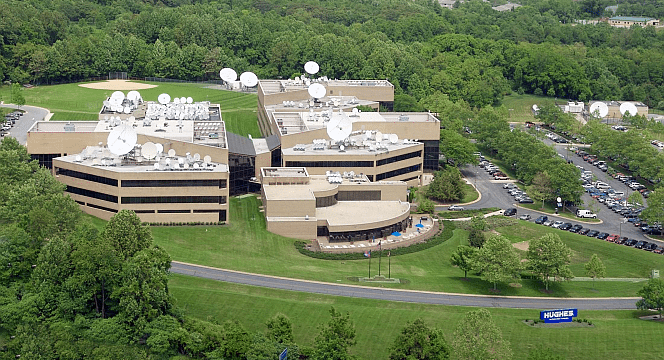Latest News

Hughes Network Systems campus in Germantown, MD. Photo Credit: Hughes
Hughes Network Systems has pushed back the launch of its Jupiter 3 satellite to the second half of 2022. The company announced the schedule change in the Fourth Quarter (Q4) financial results of parent company EchoStar Corporation on Tuesday.
“This delay is due in part to the COVID-19 restrictions that every company is facing, and in part to production issues with certain components,” Hughes President Pradman Kaul said during a quarterly results conference call Tuesday. “We are working diligently with Maxar to both mitigate these issues and identify ways to recover the schedule without risks to the satellite.”
Kaul also said that Hughes issued a contract to a launch provider for Jupiter 3 in December, but did not identify which launcher the company selected. He only mentioned that the launch vehicle they chose, “should limit the amount of time related to orbit raising.”
EchoStar CEO Michael Dugan said the company is working its options in regards to the contract with Maxar and is “very disappointed” in the delays.
When the satellite order was placed in August 2017, Hughes targeted a launch in early 2021. But during 2020, Hughes pushed back the launch to the second half of 2021, then to early 2022, and now the second half of 2022. Jupiter 3 will increase capacity and support business expansion in the United States, Canada, Mexico, Brazil, and other countries in South America.
EchoStar reported more satellite issues on Tuesday as well. Anders Johnson, EchoStar chief strategy officer, said on the investor call that the first pair of Non-Geostationary (NGSO) S-band nanosatellites launched for subsidiary EchoStar Global experienced an anomaly during the commissioning phase related to the propulsion system. These satellites were launched during Q3.
These satellites, built by Tyvak Nano-Satellite Systems, used global spectrum rights for S-band for Mobile Satellite Services (MSS) that EchoStar acquired when it bought startup Helios Wire in 2019. The subsidiary was renamed EchoStar Global.
The anomalies prevent the satellites from fulfilling their intended regulatory milestone missions and the company is seeking regulatory milestone relief. Johnson said the first satellite, EG-1, is still operational and being used for testing. Echostar Global plans to launch the third satellite in either Q2 or Q3 of this year.
2020 Financial Results
For the year that ended Dec. 31, 2020, EchoStar reported revenues of $1.89 billion, nearly unchanged from 2019. The company narrowed its net loss to $51.9 million, compared to $74.3 million in 2019.
Revenue attributable to Hughes — which makes up most of the company’s revenue — was also nearly flat from 2019, at $1.86 billion.
Hughes ended its streak of subscriber growth, reporting 1,564,000 total broadband subscribers at the end of 2020. This is down about 16,000 from the prior quarter. Subscribers in the United States decreased by 27,000 to approximately 1,189,000. This was partially offset by subscriber increase in Latin America, up 11,000 to approximately 375,000.
Kaul reiterated on the call that its U.S. offering is “capacity constrained,” and the company is managing sales and marketing efforts to optimize service to existing subscribers. He also said subscription sales slowed in the Latin American market in Q4 compared to Q3 as pandemic restrictions eased, and people began to return to homes and offices on a regular basis.
In addition, Hughes highlighted that it restarted its ground network partnership with OneWeb during the quarter, with a new, three-year contract worth $250 million. Kaul said Tuesday he believes OneWeb service will be ready to bundle with Hughes services in approximately two years.
Get the latest Via Satellite news!
Subscribe Now